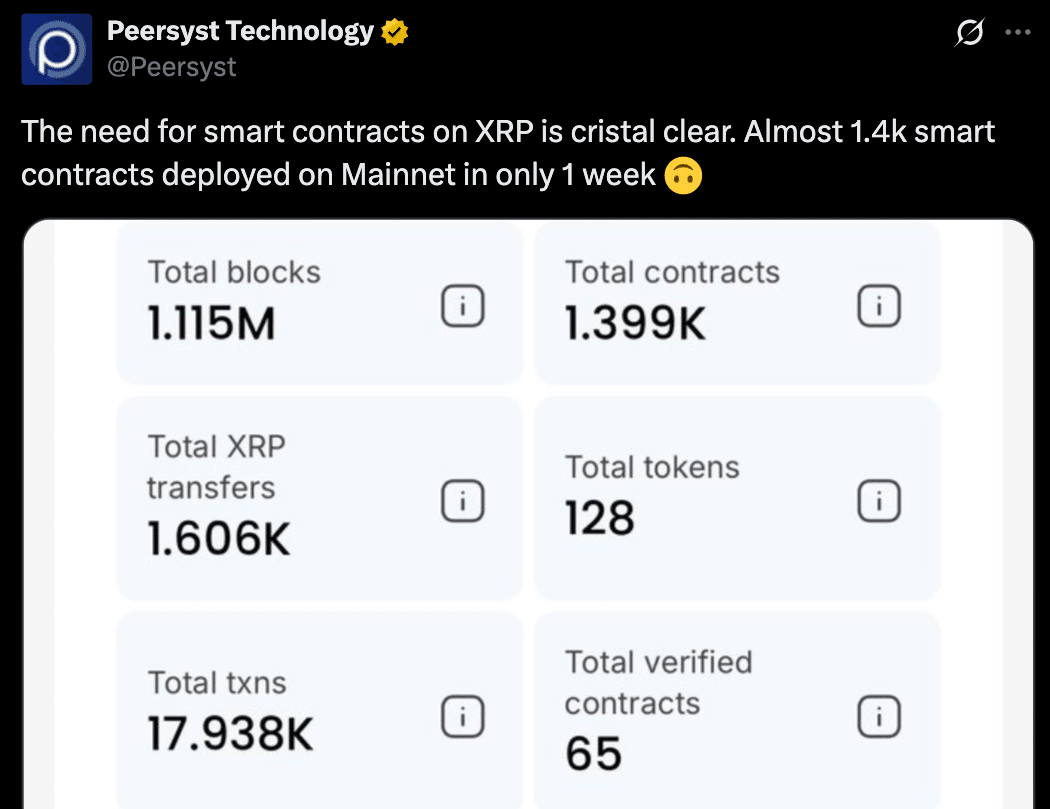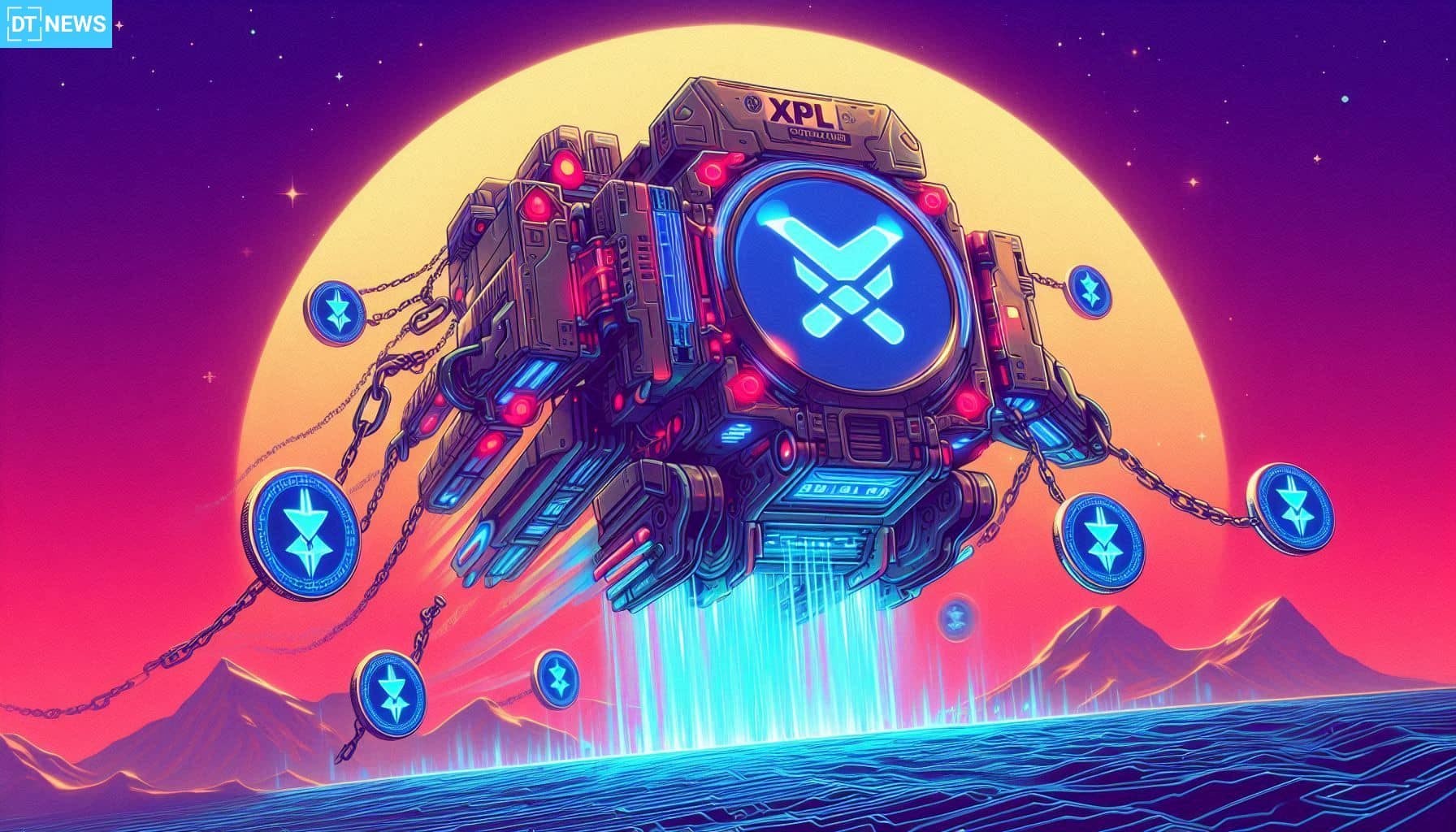The XRPL EVM sidechain is off to a technical great start with over 1,400 smart contracts in the first week. Built by Peersyst to bring Ethereum-style functionality to the XRP Ledger, it has attracted early interest from developers looking for speed and low fees. But while the infrastructure is working well, user adoption is lagging and casting a shadow over the otherwise good technical numbers.
- Smart Contracts Surge, Users Scarcity
- Technical System Working as Intended
- Bridging Ethereum, Cosmos, and XRP Ecosystems
- Developer-Friendly but Facing a User Gap
- Conclusion
- FAQ
- What is the XRPL EVM sidechain?
- How is it different from Ethereum or Solana?
- Why so few users despite many smart contracts?
- Is it secure?
- What can one build on it?
- Glossary
Smart Contracts Surge, Users Scarcity
The sidechain launched on June 30 and by July 7 had 1,412 smart contracts deployed according to Peersyst. Most of these were early DeFi experiments and protocol test deployments, many of which were Ethereum-native models like Uniswap and other yield-driven apps.

The data also shows that more than 80% of the 1,211 new accounts were created in the first 2 days and adoption stalled after that. In the days that followed, daily user activity never crossed 150 active wallets. So while the network has the technical system firing on all cylinders, the real traction it needs which is consistent users engaging with dApps, is still missing.
Technical System Working as Intended
Despite the lack of user metrics, the XRPL EVM sidechain is working as expected. 1.12 million blocks have been processed with an average block time of 5.66 seconds. For developers, this means the network is fast and reliable.
Fees are also very low. The average cost per transaction is 0.048 XRP and there’s no congestion with no pending transactions in the latest snapshots. 539 transactions were processed in the last 24 hours with total fees of 26.1 XRP. This puts the XRPL EVM sidechain among the most cost-efficient and responsive Ethereum-compatible chains live.
Bridging Ethereum, Cosmos, and XRP Ecosystems
The XRPL EVM sidechain has another advantage beyond speed and cost. Its multi-network design. Built with the Cosmos SDK and Tendermint consensus, the network is not only Ethereum Solidity and MetaMask compatible but also has native support for interoperability through bridges like Axelar and Wormhole.
These bridges allow developers to move assets between the XRP Ledger, Ethereum and other major ecosystems with minimal friction. Some of the first dApps deployed on the chain are already using these bridges and are planning cross-chain liquidity strategies and expanding the use case for XRPL beyond payment-focused solutions.
Developer-Friendly but Facing a User Gap
While the developer community is looking good, the bigger challenge is getting real users involved. Yes, the network is fast, cheap and interoperable; it supports Ethereum native tooling. But without widely adopted consumer-facing dApps, these benefits haven’t translated to daily user volume.
The sidechain is set to support DeFi, NFT minting, or even tokenized asset rollouts, but that will take time, partnerships, and incentive structures to flourish.

This also raises a big question: how will XRPL EVM differentiate itself from Avalanche, Polygon or Arbitrum; all of which also offer cheap fees, fast blocks and Ethereum compatibility?
Conclusion
For the XRPL EVM sidechain to thrive, the next phase must move beyond metrics and into utility. That means onboarding dApps with product market fit, more community grants for builders, and user-facing services like wallets and staking dashboards that reduce friction for retail participation.
Ripple’s ecosystem could also play a role. If RippleNet or its partners start to use the sidechain for tokenized real world assets (RWAs) it could be the bridge that finally drives institutional usage to a public smart contract layer.
Summary
The XRPL EVM sidechain has launched with a good start, over 1,400 smart contracts, and is showing technical strength with fast block times and low fees. But daily user engagement is low, so there’s a need for more mature dApps and real-world usage. Built on the Cosmos SDK and with bridges like Axelar and Wormhole, the sidechain allows Ethereum-style development within the XRP ecosystem.
FAQ
What is the XRPL EVM sidechain?
An Ethereum-compatible blockchain built alongside the XRP Ledger, which allows you to deploy Solidity smart contracts using XRP as gas.
How is it different from Ethereum or Solana?
XRPL EVM is faster (5.66s block times), cheaper (< $0.01 per transaction) and natively bridges with other ecosystems like Cosmos and XRP.
Why so few users despite many smart contracts?
The sidechain has strong developer traction but no mature dApps or user incentives to drive sustained usage.
Is it secure?
Yes. It uses the Tendermint consensus model, same as many Cosmos-based chains, and validators are independent.
What can one build on it?
DeFi protocols, NFT marketplaces, bridges, enterprise applications and more.
Glossary
XRPL: XRP Ledger, a blockchain for fast payments.
EVM: Ethereum Virtual Machine; a runtime for Ethereum-compatible smart contracts.
Smart Contract: A piece of code deployed on a blockchain that executes automatically based on conditions.
Tendermint: A consensus algorithm used in many Cosmos-based chains.
Axelar/Wormhole: Cross-chain bridges that allow asset transfers across multiple chains.
dApp: Decentralized Application.
RWA: Real World Assets, like tokenized stocks or property.



















































































































